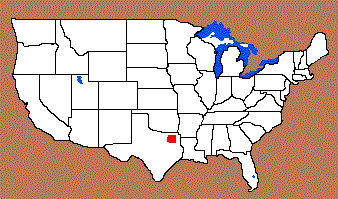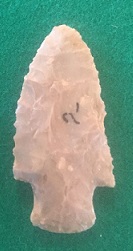Other Websites with Detailed Information:
Name Details:
Named By: LeRoy Johnson
Named For: Lone Oak, Hunt County, Texas
Date Identified: 1962
Type Site:
Lone Oak
Cluster: Williams Cluster
Commonly Utilized Material:
Date:
Cultural Period:
7,500 - 3,000 B.P.
Early Archaic or Woodland
Early Holocene or Roman Warm
Glacial Period:
Culture:
Outline is Representative of Size and Shape:
Description of Physical Characteristics and Flaking Pattern:
This is a medium
triangular expanding stem point with an elliptical cross section. The blade is primarily excurvate. The shoulders may vary
from horizontal to slightly barbed. The stem is long and expanding. The stem commonly makes up one third the length of the
point. The base is primarily convex. This point has a random flaking pattern.
Size Measurements: Data Needed
Distribution:
Distribution Comments:
This point is primarily found in northeastern Texas.

Related / Associated Points:
Additional Comments:
The dating on this point is problematic. Turner and Hester (1985) have placed this point as a Early Archaic type. Johnson et al. (2002) recognizes the
date given by Turner and Hester, but notes that the type found at Fort Polk was more consistent with a Woodland point and that it was included in the Woodland era Williams Cluster.
This point is similar to the Palmillas point, only larger and lacks the secondary pressure flaking of the Palmillas type (Johnson et al., 2002).
Pictures:


Other points in this Cluster:
Point Validity: Valid Type
Johnson was a distinguished
anthropologist who got his start in Texas before moving to become a professor at the University of Ohio and the University of Oregon. He named this type in a professional
publication and this type has many professional references. This is considered a valid type.
.
Age Details:
Pictures Provided By:
Robert Bell
References: (See Reference Page, Entry Number):
8, 30, 44
Lone Oak Projectile Point, Lone Oak Arrowhead

